Methods of modifying or imparting taste using organic compounds
Bom Ja
U.S. patent number 10,178,875 [Application Number 14/901,279] was granted by the patent office on 2019-01-15 for methods of modifying or imparting taste using organic compounds. This patent grant is currently assigned to Givaudan S.A.. The grantee listed for this patent is Givaudan, S.A.. Invention is credited to David C. Bom.



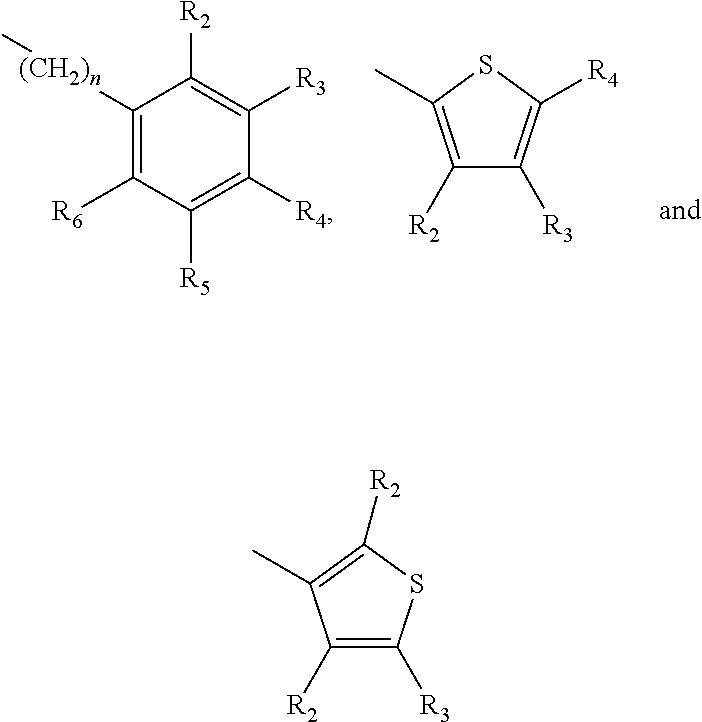
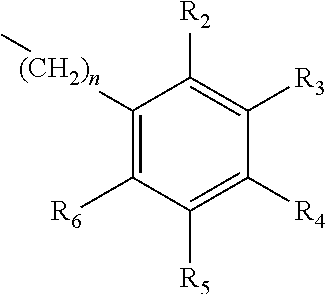
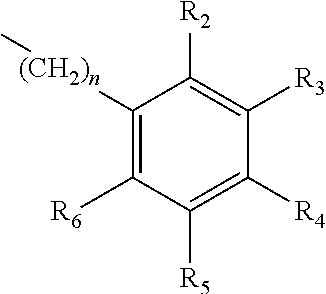
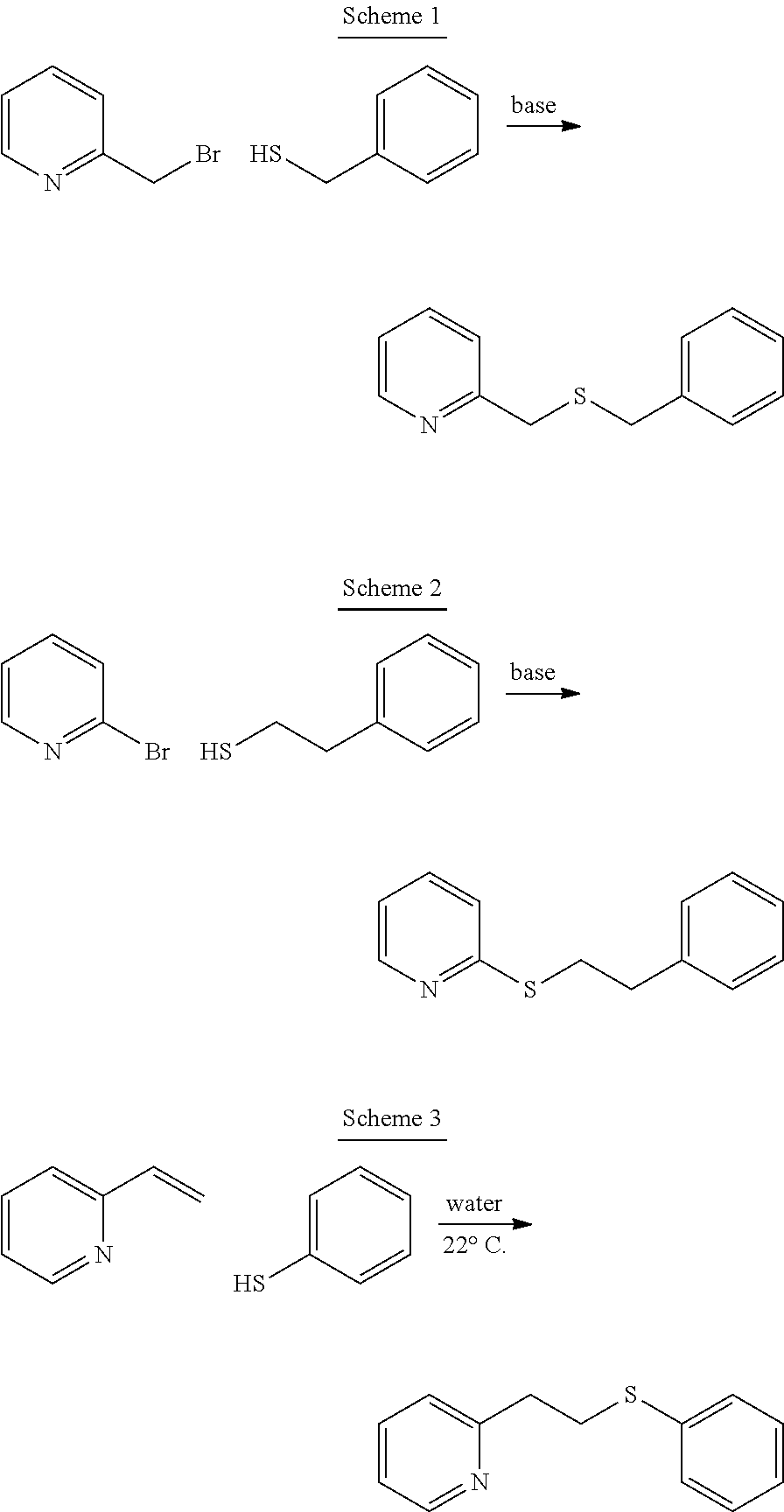

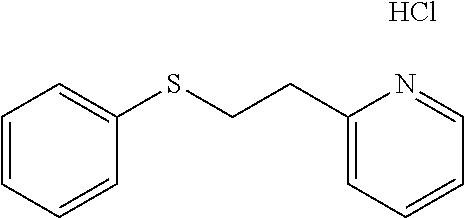
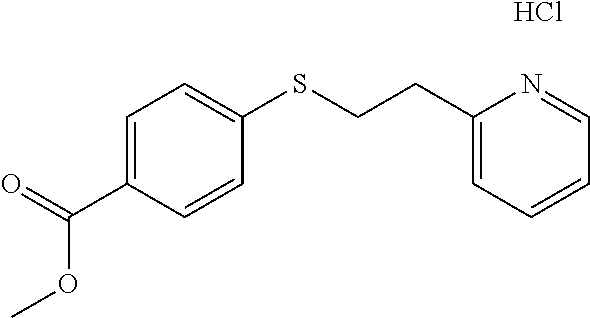
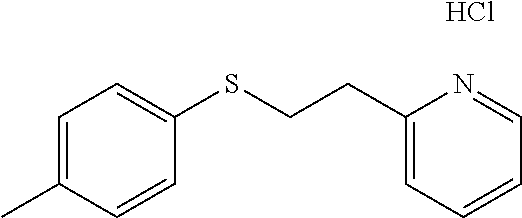
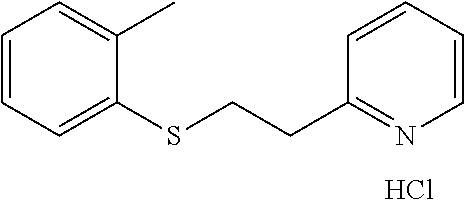
View All Diagrams
| United States Patent | 10,178,875 |
| Bom | January 15, 2019 |
Methods of modifying or imparting taste using organic compounds
Abstract
A method of imparting to, or modifying in, a comestible product, umami taste, including the addition to a comestible product base of at least one compound of formula (I) ##STR00001## wherein one of X.sub.1, X.sub.2, or X.sub.3 is selected from the group consisting of S, N and O and the remaining two are CH.sub.2; and A is selected from ##STR00002## in which R.sub.1, R.sub.2, R.sub.3, R.sub.4 R.sub.5, R.sub.6 are independently selected from the group consisting of H, methyl, ethyl, propyl, OH, OMe, OEt, COOH, COOR.sub.7, in which R.sub.7 is selected from linear or branched C.sub.1-C.sub.7 alkyl, and CONR.sub.8R.sub.9, in which R.sub.8 and R.sub.9 are independently selected from hydrogen and straight or branched C.sub.1-C.sub.4 alkyl; or any two adjacent substituents R.sub.2-R.sub.6 together form a ring of 5 or 6 members; and n is 1 or 0.
| Inventors: | Bom; David C. (Cincinnati, OH) | ||||||||||
|---|---|---|---|---|---|---|---|---|---|---|---|
| Applicant: |
|
||||||||||
| Assignee: | Givaudan S.A. (Vernier,
CH) |
||||||||||
| Family ID: | 51033217 | ||||||||||
| Appl. No.: | 14/901,279 | ||||||||||
| Filed: | July 1, 2014 | ||||||||||
| PCT Filed: | July 01, 2014 | ||||||||||
| PCT No.: | PCT/EP2014/063962 | ||||||||||
| 371(c)(1),(2),(4) Date: | December 28, 2015 | ||||||||||
| PCT Pub. No.: | WO2015/000900 | ||||||||||
| PCT Pub. Date: | January 08, 2015 |
Prior Publication Data
| Document Identifier | Publication Date | |
|---|---|---|
| US 20160366922 A1 | Dec 22, 2016 | |
Related U.S. Patent Documents
| Application Number | Filing Date | Patent Number | Issue Date | ||
|---|---|---|---|---|---|
| 61841602 | Jul 1, 2013 | ||||
| Current U.S. Class: | 1/1 |
| Current CPC Class: | C07D 213/28 (20130101); C07D 213/32 (20130101); A23L 27/2056 (20160801); A23L 27/2054 (20160801); A23V 2002/00 (20130101) |
| Current International Class: | A23L 27/20 (20160101); C07D 213/28 (20060101); C07D 213/32 (20060101) |
| Field of Search: | ;426/534,535,536,537,650 |
References Cited [Referenced By]
U.S. Patent Documents
| 2615892 | October 1952 | Clifford |
| 3226394 | December 1965 | Schipper |
| 3574221 | April 1971 | Hankovszky et al. |
| 7476399 | January 2009 | Tachdjian et al. |
| 7541055 | June 2009 | Dewis et al. |
| 7888470 | February 2011 | Li et al. |
| 8124121 | February 2012 | Tachdjian et al. |
| 8404455 | March 2013 | Li et al. |
| 8735081 | May 2014 | Li et al. |
| 8895050 | November 2014 | Tachdjian et al. |
| 9091686 | July 2015 | Li et al. |
| 9173424 | November 2015 | Wang et al. |
| 2005/0084506 | April 2005 | Tachdjian et al. |
| 2006/0068071 | March 2006 | Dewis et al. |
| 2006/0263411 | November 2006 | Tachdjian et al. |
| 2007/0104709 | May 2007 | Li et al. |
| 2008/0085994 | April 2008 | Li et al. |
| 2009/0111834 | April 2009 | Tachdjian et al. |
| 2011/0020517 | January 2011 | Rubin |
| 2011/0020518 | January 2011 | Delort et al. |
| 2011/0294981 | December 2011 | Li et al. |
| 2012/0100609 | April 2012 | Crawford et al. |
| 2012/0121783 | May 2012 | Wang et al. |
| 2012/0201763 | August 2012 | Tachdjian et al. |
| 2013/0030059 | January 2013 | Li et al. |
| 2013/0336892 | December 2013 | Li et al. |
| 2014/0295045 | October 2014 | Wang et al. |
| 2014/0342073 | November 2014 | Elings et al. |
| 2015/0084112 | March 2015 | Li et al. |
| 2015/0093339 | April 2015 | Tachdjian et al. |
| 23 16 881 | Apr 1973 | DE | |||
| 1 291 342 | Feb 2003 | EP | |||
| 1 312 268 | May 2003 | EP | |||
| 1 642 886 | Apr 2006 | EP | |||
| 1 437 781 | Jun 1976 | GB | |||
| 2000-351767 | Dec 2000 | JP | |||
| WO 03/088768 | Oct 2003 | WO | |||
| WO 2005/015158 | Feb 2005 | WO | |||
| WO 2006/003107 | Jan 2006 | WO | |||
| WO 2009/122316 | Oct 2009 | WO | |||
| WO 2009/122319 | Oct 2009 | WO | |||
| WO 2010/111713 | Sep 2010 | WO | |||
| WO 2011/004016 | Jan 2011 | WO | |||
| WO 2011/138266 | Nov 2011 | WO | |||
| WO 2013/041599 | Mar 2013 | WO | |||
Other References
|
PCT/EP2014/063962--International Search Report, dated Mar. 10, 2015. cited by applicant . PCT/EP2014/063962--International Written Opinion, dated Mar. 10, 2015. cited by applicant . PCT/EP2014/063962--International Preliminary Report on Patentability, dated Jan. 5, 2016. cited by applicant . GB1313696.5--British Search Report, dated Jan. 24, 2014. cited by applicant . Chemcats Accession No. 0090404185, Ambinter Stock Screening Collection, Publication Jan. 1, 2013, CAS Registry No. 298217-38-6. cited by applicant . Chemcats Accession No. 0072332306, Ryan Scientific Intermediate and Building Block Compounds, Publication Apr. 23, 2013, CAS Registry No. 1183541-70-9. cited by applicant . Lambrecht, et al., "Synthesis of Substituted Ethenylpryazines and Dialkylpridines and Their Sensory Properties", Flavor and Fragrance Journal, Apr. 4, 1997, pp. 439-442, vol. 12, John Wiley & Sons Ltd. cited by applicant . Profft, "Addition of Thiophenols and Thioether Ketones to 2-Vinylpyridine", Chemishe Technik, 1955, pp. 577-579, vol. 7, Leipzig, Germany. (CAS Abstract). cited by applicant . Profft, "Uber die Darstellung von Thienyl-2.2'-athylpyridyl-sulfiden", Wissenschaftliche Aeitschrift der Technischen Hochschule fur Chemie Leuna-Merseburg, 1960, pp. 101-102. cited by applicant . Profft, "Uber die Darstellung von Thienyl-2.2'-athylpyridyl-sulfiden", Institut fur Organische Chemie der Technischen Hochschule fur Chemie Leuna-Merseburg, 1959, pp. 694-696. cited by applicant . Watanabe, et al., "Intramolecular Assistance of Electron Transfer from Heteroatom Compounds. Electrochemical oxidation of 2-(2-pyridyl)ethyl-substituted ethers, sulfides, and selenides", Bulletin of the Chemical Society of Japan, 2000, pp. 243-247, vol. 73, Issue 1. (CAS Abstract). cited by applicant . Office Action dated Mar. 14, 2017, for European patent application No. 14 734 162.2-1358. cited by applicant . Office Action dated Jan. 25, 2018, for European patent application No. 14 734 162.2-1106. cited by applicant. |
Primary Examiner: Wong; Leslie A
Attorney, Agent or Firm: Curatolo Sidoti Co., LPA Curatolo; Joseph G. Sidoti; Salvatore A.
Parent Case Text
CROSS REFERENCE TO RELATED APPLICATIONS
This application is a national stage application of International Application No. PCT/EP2014/063962, filed 1 Jul. 2014, which claims priority from U.S. Provisional Patent Application No. 61/841,602, filed 1 Jul. 2013, which applications are incorporated herein by reference.
Claims
The invention claimed is:
1. A method of imparting to, or modifying in, a comestible product, umami taste comprising the addition to a comestible product base of at least one compound of formula (I) ##STR00021## wherein one of X.sub.1, X.sub.2, or X.sub.3 is selected from the group consisting of S, N and O and the remaining two are CH.sub.2; and A is selected from ##STR00022## in which R.sub.2, R.sub.3, R.sub.4, R.sub.5, R.sub.6 are independently selected from the group consisting of H, methyl, ethyl, propyl, OH, OMe, OEt, COOH, COOR.sub.7, in which R.sub.7 is selected from linear C.sub.1-C.sub.7 alkyl, branched C.sub.3-C.sub.7 alkyl, and CONR.sub.8R.sub.9, in which R.sub.8 and R.sub.9 are independently selected from hydrogen, straight C.sub.1-C.sub.4 alkyl, and branched C.sub.3-C.sub.4 alkyl; or any two adjacent substituents R.sub.2-R.sub.6 together form a ring of 5 or 6 members; and n is 1 or 0.
2. The method according to claim 1, in which one of X.sub.1, X.sub.2, or X.sub.3 is S and the remaining two are CH.sub.2.
3. The method according to claim 1, in which X.sub.1 is S, and, X.sub.2 and X.sub.3 are CH.sub.2.
4. The method according to claim 1, in which X.sub.2 is S, and, X.sub.1 and X.sub.3 are CH.sub.2.
5. The method according to claim 1, in which A is ##STR00023## in which R.sub.2, R.sub.3, R.sub.4, R.sub.5, R.sub.6 are independently selected from the group consisting of H, methyl, ethyl, propyl, OH, OMe, OEt, COOH, COOR.sub.7, in which R.sub.7 is selected from linear C.sub.1-C.sub.7 alkyl, branched C.sub.3-C.sub.7 alkyl, and CONR.sub.8R.sub.9, in which R.sub.8 and R.sub.9 are independently selected from hydrogen, straight C.sub.1-C.sub.4 alkyl, and branched C.sub.3-C.sub.4 alkyl; or any two adjacent substituents R.sub.2-R.sub.6 together form a ring of 5 or 6 members; and n is 1 or 0.
6. The method according to claim 1, in which X.sub.1 is S, and, X.sub.2 and X.sub.3 are CH.sub.2, and A is ##STR00024## in which R.sub.2, R.sub.3, R.sub.4, R.sub.5, R.sub.6 are independently selected from the group consisting of H, methyl, ethyl, propyl, OH, OMe, OEt, COOH, and COOR.sub.7, in which R.sub.7 is selected from linear C.sub.1-C.sub.7 alkyl and branched C.sub.3-C.sub.7 alkyl, and n is 0.
7. The method according to claim 1, in which the compound of formula (I) is selected from the group consisting of: 2-(2-(Phenylthio)ethyl)pyridine, 2-(2-(Phenylthio)ethyl)pyridine hydrochloride, Methyl 4-((2-(pyridin-2-yl)ethyl)thio) benzoate hydrochloride, 2-(2-(p-tolylthio)ethyl)pyridine hydrochloride, 2-(2-(o-tolylthio) ethyl)pyridine hydrochloride, 4-((2-(pyridin-2-yl)ethyl)thio)phenol, 2-((2-(pyridin-2-yl) ethyl)thio)phenol, 2-(2-((3-methoxyphenyl)thio)ethyl)pyridine, Methyl 2-((2-(pyridin-2-yl)ethyl)thio)benzoate hydrochloride, 3-((2-(pyridin-2-yl)ethyl)thio)phenol, 2-(2-(benzylthio)ethyl)pyridine, 2-(2-(m-Tolylthio)ethyl)pyridine hydrochloride, and 2-(2-((4-Methoxyphenyl)-thio)ethyl)pyridine hydrochloride.
8. The method according to claim 1, in which the compound of formula (I) is a salt.
9. The method according to claim 8, in which the compound of formula (I) is in the form of hydrochloride salt.
10. A method of imparting to, or modifying in, a flavour composition or comestible product, salt taste, comprising the addition to said flavour composition or comestible product of at least one compound of formula (I) ##STR00025## wherein one of X.sub.1, X.sub.2, or X.sub.3 is selected from the group consisting of S, N and O and the remaining two are CH.sub.2; and A is selected from ##STR00026## in which R.sub.2, R.sub.3, R.sub.4, R.sub.5, R.sub.6 are independently selected from the group consisting of H, methyl, ethyl, propyl, OH, OMe, OEt, COOH, COOR.sub.7, in which R.sub.7 is selected from linear C.sub.1-C.sub.7 alkyl, branched C.sub.3-C.sub.7 alkyl, and CONR.sub.8R.sub.9, in which R.sub.8 and R.sub.9 are independently selected from hydrogen, straight C.sub.1-C.sub.4 alkyl, and branched C.sub.3-C.sub.4 alkyl; or any two adjacent substituents R.sub.2-R.sub.6 together form a ring of 5 or 6 members; and n is 1 or 0.
11. A method of imparting to, or modifying in, a flavour composition or comestible product, a fruity, green, green pepper, tomato and/or bell pepper aroma, comprising the addition to said flavour composition or comestible product of at least one compound of formula (I) ##STR00027## wherein one of X.sub.1, X.sub.2, or X.sub.3 is selected from the group consisting of S, N and O and the remaining two are CH.sub.2; and A is selected from ##STR00028## in which R.sub.2, R.sub.3, R.sub.4 R.sub.5, R.sub.6 are independently selected from the group consisting of H, methyl, ethyl, propyl, OH, OMe, OEt, COOH, COOR.sub.7, in which R.sub.7 is selected from linear C.sub.1-C.sub.7 alkyl, branched C.sub.3-C.sub.7 alkyl, and CONR.sub.8R.sub.9, in which R.sub.8 and R.sub.9 are independently selected from hydrogen, straight C.sub.1-C.sub.4 alkyl, and branched C.sub.3-C.sub.4 alkyl; or any two adjacent substituents R.sub.2-R.sub.6 together form a ring of 5 or 6 members; and n is 1 or 0.
12. A method of imparting to, or modifying in, a flavour composition or comestible product, a kokumi sensation, comprising the addition to said flavour composition or comestible product of at least one compound of formula (I) ##STR00029## wherein one of X.sub.1, X.sub.2, or X.sub.3 is selected from the group consisting of S, N and O and the remaining two are CH.sub.2; and A is selected from ##STR00030## in which R.sub.2, R.sub.3, R.sub.4 R.sub.5, R.sub.6 are independently selected from the group consisting of H, methyl, ethyl, propyl, OH, OMe, OEt, COOH, COOR.sub.7, in which R.sub.7 is selected from linear C.sub.1-C.sub.7 alkyl, branched C.sub.3-C.sub.7 alkyl, and CONR.sub.8R.sub.9, in which R.sub.8 and R.sub.9 are independently selected from hydrogen, straight C.sub.3-C.sub.7 alkyl, and branched C.sub.3-C.sub.4 alkyl; or any two adjacent substituents R.sub.2-R.sub.6 together form a ring of 5 or 6 members; and n is 1 or 0.
13. The method according to claim 1, in which the at least one compound of formula (I) is added in a concentration of from 0.01 ppm to 500 ppm by weight based on the weight of the comestible product.
14. The method according to claim 10, in which the at least one compound of formula (I) is added in a concentration of from 0.01 ppm to 500 ppm by weight based on the weight of the comestible product, or at a concentration of 0.01% to 99.9% by weight of flavour components of the flavour composition.
15. The method according to claim 11, in which the at least one compound of formula (I) is added in a concentration of from 0.01 ppm to 500 ppm by weight based on the weight of the comestible product, or at a concentration of 0.01% to 99.9% by weight of flavour components of the flavour composition.
16. The method according to claim 12, in which the at least one compound of formula (I) is added in a concentration of from 0.01 ppm to 500 ppm by weight based on the weight of the comestible product, or at a concentration of 0.01% to 99.9% by weight of flavour components of the flavour composition.
Description
This disclosure relates to the use of compounds that can impart or modify umami taste in comestible products.
Umami taste is an important flavour sensation. Accordingly, in the flavour industry there is a constant demand for compounds that impart or modify it.
Such compounds extend a flavourist's palette and result in greater product diversity for consumers. Furthermore, such compounds may replace, or reduce reliance, on compounds conventionally used to impart or modify these tastes e.g. monosodium glutamate (MSG), the use of which may be undesirable.
It has now been found that certain compounds), as defined herein, may be used to impart to, or modify in, a flavour composition or comestible product, umami taste.
There is therefore provided a method of imparting to, or modifying in, a flavour composition or comestible product, umami taste, comprising the addition to said flavour composition or comestible product of at least one compound of formula (I)
##STR00003##
wherein:
one of X.sub.1, X.sub.2, or X.sub.3 is selected from the group consisting of S, N and O and the remaining two are CH.sub.2; and A is selected from
##STR00004##
in which R.sub.1, R.sub.2, R.sub.3, R.sub.4 R.sub.5, R.sub.6 are independently selected from the group consisting of H, methyl, ethyl, propyl, OH, OMe, OEt, COOH, COOR.sub.7, in which R.sub.7 is selected from linear or branched C.sub.1-C.sub.7 alkyl, and CONR.sub.8R.sub.9, in which R.sub.8 and R.sub.9 are independently selected from hydrogen and straight or branched C.sub.1-C.sub.4 alkyl; or any two adjacent substituents R.sub.2-R.sub.6 together form a ring of or 6 members; and n is 1 or 0. The abbreviation Me represents --CH.sub.3; Et represents --C.sub.2CH.sub.3.
In a particular embodiment, one of X.sub.1, X.sub.2, or X.sub.3 is S and the remaining two are CH.sub.2.
In a further particular embodiment, X.sub.1 is S and X.sub.2, and X.sub.3 are CH.sub.2.
In a further particular embodiment, X.sub.2 is S and X.sub.1, and X.sub.3 are CH.sub.2.
In a further particular embodiment, A is
##STR00005##
in which R.sub.1, R.sub.2, R.sub.3, R.sub.4 R.sub.5, R.sub.6 are independently selected from the group consisting of H, methyl, ethyl, propyl, OH, OMe, OEt, COOH, COOR.sub.7, in which R.sub.7 is selected from linear or branched C.sub.1-C.sub.7 alkyl, and CONR.sub.8R.sub.9, in which R.sub.8 and R.sub.9 are independently selected from hydrogen and straight or branched C.sub.1-C.sub.4 alkyl; or any two adjacent substituents R.sub.2-R.sub.6 together form a ring of 5 or 6 members; and n is 1 or 0.
In a further particular embodiment, X.sub.1 is S and X.sub.2, and X.sub.3 are CH.sub.2, and A is
##STR00006##
in which R.sub.1, R.sub.2, R.sub.3, R.sub.4 R.sub.5, R.sub.6 are independently selected from the group consisting of H, methyl, ethyl, propyl, OH, OMe, OEt, COOH, and COOR.sub.7, in which R.sub.7 is selected from linear or branched C.sub.1-C.sub.7 alkyl, and n is 0.
In a further particular embodiment, the compound of formula (I) is selected from the group consisting of:
2-(2-(Phenylthio)ethyl)pyridine, 2-(2-(Phenylthio)ethyl)pyridine hydrochloride, Methyl 4-((2-(pyridin-2-yl)ethyl)thio)benzoate hydrochloride, 2-(2-(p-tolylthio)ethyl)pyridine hydrochloride, 2-(2-(o-tolylthio)ethyl)pyridine hydrochloride, 4-((2-(pyridin-2-yl)ethyl)thio)phenol, 2-((2-(pyridin-2-yl)ethyl)thio)phenol, 2-(2-((3-methoxyphenyl)thio)ethyl)pyridine, Methyl 2-((2-(pyridin-2-yl)ethyl)thio)benzoate hydrochloride, 3-((2-(pyridin-2-yl)ethyl)thio)phenol, 2-(2-(benzylthio)ethyl)pyridine, 2-(2-(m-Tolylthio)ethyl)pyridine hydrochloride, and 2-(2-((4-Methoxyphenyl)thio)ethyl)pyridine hydrochloride.
A compound of formula I may be used in the form as shown above, or in its ionic form with or without a counter-ion (in the form of its salt), for example it may be used in the form of its sodium, potassium, calcium, ammonium, chloride, hydrochloride, sulphate, phosphate, carbonate, or similar physiologically-acceptable counter-ion salt.
In a further particular embodiment, the compound of formula (I) is a salt.
In a further particular embodiment, the compound of formula (I) is in the form of the hydrochloride salt.
The compounds of formula (1) may be prepared by methods well known to the art.
In particular, the compounds of formula (I) may be prepared in one step by reacting an appropriately ortho-substituted nitrogen-bearing heterocycle and an appropriately substituted phenylthiol; as shown in the following reaction schemes:
##STR00007##
Other examples of suitable generally-applicable methods are described in, for example, Profft in Monatsberichte der Deutschen Akademie der Wissentschaften zu Berlin, 1 (1959), No. 11, 694-6, Profft in Wissentschaftliche Zeitschrift der Technischen Hochschule fur Chemie "Carl Schorlemmer" Leuna-Merseburg (1960) 101-2, Bentley et al in WO 2011/138266 and Tagaki et al in JP 2000-351767.
Further details of suitable synthesis routes to the compounds of formula (I) are set forth in the examples, described below.
The reaction conditions, that is, the choice of solvent, temperature, pH and the like, appropriate for affecting the chemical syntheses described above are well known in the art and require no further elaboration here. Particular reaction conditions are set forth in the examples below.
Some of the compounds prepared as hereinabove described are novel compounds. There is therefore also provided a compound of the formula I, or the hydrochloride salt thereof, in which X.sub.1 and X.sub.2 are CH.sub.2, X.sub.3 is sulfur and A is a mono-substituted phenyl, the substituent being selected from CH.sub.3, OH, OCH.sub.3 COOH, COOR.sub.7, in which R.sub.7 is selected from linear or branched C.sub.1-C.sub.7 alkyl, and CONR.sub.7R.sub.8, in which R.sub.8 and R.sub.9 are independently selected from hydrogen and straight or branched C.sub.1-C.sub.4 alkyl.
It has also been found that the compounds of formula (I) may impart, or modify one or more other olfactory, gustatory or trigeminal flavour sensations e.g. aroma, taste and mouth feel.
In particular it has been found that the compound of formula (I), as defined herein, may be used to impart to, or modify in, a flavour composition or comestible product, salt taste, fruity, green, green pepper, tomato and/or bell pepper aroma, and/or kokumi sensation.
In an particular embodiment, there is provided a method of imparting to, or modifying in, a flavour composition or comestible product, salt taste, comprising the addition to said flavour composition or comestible product of at least one compound of formula (I) as defined herein.
In a further particular embodiment, there is provided a method of imparting to, or modifying in, a flavour composition or comestible product, a fruity, green, green pepper, tomato and/or bell pepper aroma, comprising the addition to said flavour composition or comestible product of at least one compound of formula (I) as defined herein.
In a further particular embodiment, there is provided a method of imparting to, or modifying in, a flavour composition or comestible product, the kokumi sensation, comprising the addition to said flavour composition or comestible product of at least one compound of formula (I) as defined herein.
The term "Kokumi sensation" is a term used in the flavour industry to describe characteristics such as salivating, continuity, mouthfulness, richness and thickness.
The term "modify" as used herein refers to the ability of a compound of formula (I) to alter the perception of one or more olfactory, gustatory, or trigeminal flavour sensation e.g. aroma, taste and/or mouthfeel.
The compounds of formula (I) may alter the perception of one or more olfactory, gustatory, or trigeminal flavour sensation temporally, or by altering the quality or intensity for example by enhancing, strengthening, softening or sharpening.
The temporal profile of a taste or flavour includes three aspects, the very first taste or flavour sensation ("initial impact"), the medium taste or flavour sensation ("body"), and the time period during which taste or flavour lasts or lingers ("lingering period"). Typically the `initial impact` lasts from 0 to 5 seconds, the `body` lasts between 5 to 20 seconds, and the `lingering period` lasts from 20 seconds onwards.
The compounds of formula (I) may be added into a composition in neat form, or they may first be modified, for example they may be entrapped or encapsulated with an entrapment or encapsulation material such as for example polymers, capsules, microcapsules, nanocapsules, liposomes, precursors, film formers, absorbents such as for example by using carbon or zeolites, cyclic oligosaccharides and mixtures thereof, or they may be chemically bound to substrates which are adapted to release the compounds of formula (I) upon application of an exogenous stimulus such as light, enzymes, or the like. The compounds of formula (I) may be modified in order to achieve a desired technical effect such as to achieve stability or to effect controlled release.
In a further particular embodiment, there is provided a flavour composition or comestible product comprising at least one compound of formula I as defined herein.
A compound of formula (I) may be the sole flavouring component in a flavour composition or comestible product or, a compound of formula (I) may be used in conjunction with other compounds of formula (I) and/or additional flavour ingredients.
Additional flavour ingredients may be selected from natural flavours, artificial flavours, spices, seasonings, and the like, synthetic flavour oils and flavouring aromatics and/or oils, oleoresins, essences, distillates, and extracts derived from plants, leaves, flowers, fruits, and so forth, Generally, any flavouring or food additive such as those described in Chemicals Used in Food Processing, publication 1274, pages 63-258, by the National Academy of Sciences, can be used.
Particular examples of other umami compounds that may be employed as additional flavour ingredients include the compounds described in International Publication No. WO12011/004016. Other non-limiting examples of umami flavour-conferring and -enhancing compounds include those described in EP 1642886, WO 2005/015158, EP 1312268, WO 2003/088768, EP 1291342 and WO 2006/003107.
A compound of formula (I) can additionally be used in flavour compositions or comestible products, as described hereinabove, in conjunction with one or more ingredients or excipients conventionally used in flavour compositions or comestible products, for example carrier materials and other auxiliary agents commonly used in the art. Suitable excipients for flavour compositions and comestible products are well known in the art and include, for example, without limitation, solvents (including water, alcohol, ethanol, oils, fats, vegetable oil, and miglyol), binders, diluents, disintegranting agents, lubricants, flavouring agents, coloring agents, preservatives, antioxidants, emulsifiers, stabilisers, flavour-enhancers, anti-caking agents, and the like.
Examples of such carriers or diluents for flavour compositions and comestible products may be found in for example, "Perfume and Flavour Materials of Natural Origin", S. Arctander, Ed., Elizabeth, N.J., 1960; in "Perfume and Flavour Chemicals", S. Arctander, Ed., Vol. I & II, Allured Publishing Corporation, Carol Stream, USA, 1994; in "Flavourings", E. Ziegler and H. Ziegler (ed.), Wiley-VCH Weinheim, 1998, and "CTFA Cosmetic Ingredient Handbook", J. M. Nikitakis (ed.), 1st ed., The Cosmetic, Toiletry and Fragrance Association, Inc., Washington, 1988.
Other suitable and desirable ingredients of flavour compositions and comestible products are described in standard texts, such as "Handbook of Industrial Chemical Additives", ed. M. and I. Ash, 2.sup.nd Ed., (Synapse 2000).
The compounds of formula (I) may be used in a flavour composition at a concentration of up to 100% by weight of the flavour ingredients. However, more commonly compounds of formula (I) will be used with additional flavour ingredients at a concentration of 0.01% to 99.9% by weight of the flavour components of the flavour composition.
The concentration in which a compounds of formula (I) may be added to comestible products may vary within wide limits and depend, inter alia, on the nature of the comestible product, on the effect desired, the purpose of adding compounds of formula (I) to a comestible product, for example imparting or enhancing a umami taste, and on the nature and quantity of any other components of the consumable product.
Non-limiting exemplary concentrations of compounds of formula (I), in ppm by weight based on the weight of the comestible product, may be: 500 ppm to 0.01 ppm, more particularly 250 ppm to 0.01 ppm, still more particularly 100 ppm to 1 ppm.
A compound of formula (I), or flavour compositions comprising at least one compound of formula (I), may be added to comestible products by using conventional techniques to directly admix said compounds or compositions into the comestible product.
The use of the compounds of formula (I) in flavour compositions and comestible products enables the levels of other umami taste-imparting or modifying ingredients e.g. MSG and ribonucleotides such as disodium inosinate, and disodium guanylate (typically added to MSG as enhancers at low MSG levels), ordinarily present in flavour compositions and comestible products, to be reduced.
It is customary to employ MSG in such amounts such that, when a flavour composition is added to a comestible product, the MSG is present in amounts of between about 200 to 500 ppm. In reduced MSG comestible products, the amount of MSG is usually a lower amount in the range of about 100 to 200 ppm. In the case of ribonucleotides, the proportion may be from about 5 to ppm.
Compounds of formula (I) may be used to reduce up to 99.9% of the MSG or ribonucleotides in a flavour composition or comestible product. However, more commonly compounds of formula (I) will be used to reduce 10-35%, 10-25%, of the MSG, or ribonucleotides in a flavour composition or comestible product.
The term "comestible product(s)" refers to any composition that is put in the mouth and consumed, or that is placed in the mouth to achieve an effect before being discarded. By "comestible product base" is meant all the ingredients that make up a comestible product, apart from the compounds of formula (I). All of the standard ingredients known to the art may be employed in art-recognised quantities and the person skilled in the art will either know what can be used in every situation, or can find this by routine, non-inventive experimentation. These include, but are not limited to, anti-caking agents, anti-foaming agents, anti-oxidants, binders, colourants, diluents, disintegrants, emulsifiers, encapsulating agents or formulations, enzymes, fats, flavour-enhancers, flavouring agents, gums, lubricants, polysaccharides, preservatives, proteins, solubilisers, solvents, stabilisers, sugar-derivatives, surfactants, sweetening agents, vitamins, waxes, and the like. Solvents which may be used are known to those skilled in the art and include e.g. ethanol, ethylene glycol, propylene glycol, glycerine and triacetin. Encapsulants and gums include maltodextrin, gum arabic, alginates, gelatine, modified starch, and polysaccharides. Examples of additives, excipients, carriers, diluents or solvents for flavour or fragrance compounds may be found e.g. in "Perfume and Flavour Materials of Natural Origin", S. Arctander, Ed., Elizabeth, N.J., 1960; in "Perfume and Flavour Chemicals", S. Arctander, Ed., Vol. I & II, Allured Publishing Corporation, Carol Stream, USA, 1994; in "Flavourings", E. Ziegler and H. Ziegler (ed.), Wiley-VCH Weinheim, 1998, and "CTFA Cosmetic Ingredient Handbook", J. M. Nikitakis (ed.), 1st ed., The Cosmetic, Toiletry and Fragrance Association, Inc., Washington, 1988.
The compounds of formula (I) can be added to all manner of comestible products.
Examples include, but are not limited to, foodstuffs of all kinds, confectionery products, baked products, sweet products, savory products, dairy products, beverages and oral care products.
Exemplary foodstuffs include, but are not limited to, chilled snacks, sweet and savory snacks, fruit snacks, chips/crisps, extruded snacks, tortilla/corn chips, popcorn, pretzels, nuts, other sweet and savory snacks, snack bars, granola bars, breakfast bars, energy bars, fruit bars, other snack bars, meal replacement products, slimming products, convalescence drinks, ready meals, canned ready meals, frozen ready meals, dried ready meals, chilled ready meals, dinner mixes, frozen pizza, chilled pizza, soup, canned soup, dehydrated soup, instant soup, chilled soup, uht soup, frozen soup, pasta, canned pasta, dried pasta, chilled/fresh pasta, noodles, plain noodles, instant noodles, cups/bowl instant noodles, pouch instant noodles, chilled noodles, snack noodles, dried food, dessert mixes, sauces, dressings and condiments, herbs and spices, spreads, jams and preserves, honey, chocolate spreads, nut-based spreads, and yeast-based spreads.
Exemplary confectionery products include, but are not limited to, chewing gum (which includes sugarized gum, sugar-free gum, functional gum and bubble gum), centerfill confections, chocolate and other chocolate confectionery, medicated confectionery, lozenges, tablets, pastilles, mints, standard mints, power mints, chewy candies, hard candies, boiled candies, breath and other oral care films or strips, candy canes, lollipops, gummies, jellies, fudge, caramel, hard and soft panned goods, toffee, taffy, liquorice, gelatin candies, gum drops, jelly beans, nougats, fondants, combinations of one or more of the above, and edible compositions incorporating one or more of the above.
Exemplary baked products include, but are not limited to, alfajores, bread, packaged/industrial bread, unpackaged/artisanal bread, pastries, cakes, packaged/industrial cakes, unpackaged/artisanal cakes, cookies, chocolate coated biscuits, sandwich biscuits, filled biscuits, savory biscuits and crackers, and bread substitutes.
Exemplary sweet products include, but are not limited to, breakfast cereals, ready-to-eat ("rte") cereals, family breakfast cereals, flakes, muesli, other rte cereals, children's breakfast cereals, and hot cereals.
Exemplary savory products include, but are not limited to, salty snacks (potato chips, crisps, nuts, tortilla-tostada, pretzels, cheese snacks, corn snacks, potato-snacks, ready-to-eat popcorn, microwaveable popcorn, pork rinds, nuts, crackers, cracker snacks, breakfast cereals, meats, aspic, cured meats (ham, bacon), luncheon/breakfast meats (hotdogs, cold cuts, sausage), tomato products, margarine, peanut butter, soup (clear, canned, cream, instant, UHT), canned vegetables, and pasta sauces.
Exemplary dairy products include, but are not limited to, ice cream, impulse ice cream, single portion dairy ice cream, single portion water ice cream, multi-pack dairy ice cream, multi-pack water ice cream, take-home ice cream, take-home dairy ice cream, ice cream desserts, bulk ice cream, take-home water ice cream, frozen yoghurt, artisanal ice cream, dairy products, milk, fresh/pasteurized milk, full fat fresh/pasteurized milk, semi skimmed fresh/pasteurized milk, long-life/uht milk, full fat long life/uht milk, semi skimmed long life/uht milk, fat-free long life/uht milk, goat milk, condensed/evaporated milk, plain condensed/evaporated milk, flavoured, functional and other condensed milk, flavoured milk drinks, dairy only flavoured milk drinks, flavoured milk drinks with fruit juice, soy milk, sour milk drinks, fermented dairy drinks, coffee whiteners, powder milk, flavoured powder milk drinks, cream, yoghurt, plain/natural yoghurt, flavoured yoghurt, fruited yoghurt, probiotic yoghurt, drinking yoghurt, regular drinking yoghurt, probiotic drinking yoghurt, chilled and shelf-stable desserts, dairy-based desserts, and soy-based desserts.
Exemplary beverages include, but are not limited to, flavoured water, soft drinks, fruit drinks, coffee-based drinks, tea-based drinks, juice-based drinks (includes fruit and vegetable), milk-based drinks, gel drinks, carbonated or non-carbonated drinks, powdered drinks, alcoholic or non-alcoholic drinks.
There now follows a series of non-limiting illustrative examples.
EXAMPLE 1: 2-(2-(PHENYLTHIO)ETHYL)PYRIDINE (CAS: 21070-71-3)
##STR00008##
Benzenethiol (4.66 ml, 45.4 mmol) was added to Water (20 ml) followed by 2-vinylpyridine (4.89 ml, 45.4 mmol) and the contents were stirred overnight at room temperature (rt). The next day the product was extracted with ethyl acetate (100 ml). The organic layer was dried (Na.sub.2SO.sub.4), filtered and concentrated providing an oil. The crude oil was purified by column chromatography on SiO.sub.2 using a gradient of 100% hexane to 50:50 hexane:EtOAc providing the desired 2-(2-(phenylthio)ethyl)pyridine (8.2 g, 84% yield) as a clear oil. .sup.1H NMR (300 MHz, d.sub.6-DMSO, ppm) .delta. 3.019 (t, J=7 Hz, 2H), 3.34 (t, J=7 Hz, 2H), 7.08-7.40 (m, 7H), 7.66-7.71 (m, 1H), 8.49-8.51 (m, 1H); .sup.13C NMR (75 MHz, d.sub.6-DMSO, ppm) .delta. 31.5, 36.8, 121.6, 123.1, 125.6, 128.0, 129.0, 136.1, 136.4, 149.0, 159.2; GC/MS calculated for C.sub.13H.sub.13NS 215, observed 215.
EXAMPLE 2: 2-(2-(PHENYLTHIO)ETHYL)PYRIDINE HYDROCHLORIDE (CAS: 21070-72-4)
##STR00009##
A portion of 2-(2-(phenylthio)ethyl)pyridine from example 1 was dissolved in ether and treated with HCl gas resulting in a sticky oil. Scratching the walls of the vial with a metal spatula induced crystallization providing the desired 2-(2-(phenylthio)ethyl)-pyridine hydrochloride as a white solid. The ether was removed by filtration and the white solid was dried overnight in a vacuum oven at 40.degree. C. .sup.1H NMR (300 MHz, d.sub.6-DMSO, ppm) .delta. 3.38 (t, J=7 Hz, 2H), 3.50-3.55 (m, 2H), 7.16-7.22 (m, 1H), 7.27-7.39 (m, 4H), 7.84-7.89 (m, 1H), 7.96 (d, J=8 Hz, 1H), 8.75-8.78 (m, 1H); .sup.13C NMR (75 MHz, d.sub.6-DMSO, ppm) .delta. 30.7, 32.6, 124.9, 126.0, 127.3, 128.4, 129.1, 134.9, 141.5, 145.2, 154.6.
EXAMPLE 3: METHYL 4-((2-(PYRIDIN-2-YL)ETHYL)THIO)BENZOATE HYDROCHLORIDE (CAS: 298217-38-6)
##STR00010##
Methyl 4-mercaptobenzoate (1 g, 5.94 mmol) was added to a 20 ml vial followed by Water (2.62 ml) and 2-vinylpyridine (0.641 ml, 5.94 mmol). The mixture was stirred overnight. The next day, the reaction mixture was diluted with ethyl acetate (10 ml) and passed through a Chem Elut extraction cartridge (Varian). The cartridge was washed several times with EtOAc. The dried theyl acetate and rinsings were collected in a 100 ml round bottom flask. The solvent was concentrated producing a crude cream colored solid. A TLC on silica gel using 50:50 hexane:EtOAc showed a single spot with an Rf of .about.0.8. The solid was dissolved in dichloromethane and chromatographed on SiO.sub.2 using a gradient of 100% hexane to 50:50 hexane:EtOAc. The product containing fractions were concentrated and the purified product was dissolved in ether and HCl gas was bubbled through. This generated a white, sticky oil that solidified into a white solid, when the vial was scratched with a spatula. The white solid was dried overnight at 40.degree. C. in a vacuum oven providing the desired methyl 4-((2-(pyridin-2-yl)ethyl)thio)benzoate hydrochloride as a white solid (1.53 g, 83% yield). .sup.1H NMR (300 MHz, d.sub.6-DMSO, ppm) .delta. 3.43 (t, J=7 Hz, 2H), 3.62 (t, J=7 Hz, 2H), 3.83 (s, 3H), 7.47-7.51 (m, 2H), 7.83-7.91 (m, 3H), 8.00 (d, J=8 Hz, 1H), 8.47 (td, J.sub.1=8 Hz, J.sub.2=2 Hz, 1H), 8.78-8.80 (m, 1H); .sup.13C NMR (75 MHz, d.sub.6-DMSO, ppm) .delta. 29.4, 32.3, 52.0, 125.0, 126.3, 126.5, 127.3, 129.6, 141.6, 142.5, 145.3, 154.4, 165.8; GC/MS (Free base) calculated for C.sub.15H.sub.15NO.sub.2S 273, observed 273.
EXAMPLE 4: 2-(2-(P-TOLYLTHIO)ETHYL)PYRIDINE HYDROCHLORIDE (CAS: 109845-78-5)
##STR00011##
4-Methylbenzenethiol (0.738 g, 5.94 mmol) was added to a 20 ml vial followed by Water (2.62 ml) and 2-vinylpyridine (0.641 ml, 5.94 mmol). The mixture was stirred overnight. The next day, the reaction mixture was diluted with ethyl acetate (10 ml) and passed through a Chem Elut extraction cartridge (Varian). The cartridge was washed several times with EtOAc and the dried reaction and rinsings were collected in a 100 ml round bottom flask. The solvent was concentrated producing a crude cream colored solid. A TLC on silica gel using 50:50 hexane:EtOAc showed a single spot with an Rf of .about.0.8. The solid was dissolved in dichloromethane and chromatographed on SiO.sub.2 using a gradient of 100% hexane to 50:50 hexane:EtOAc. The resulting product was dissolved in ether and treated with HCl gas. This produced, after scratching with a spatula and vacuum oven drying at 40.degree. C., the desired 2-(2-(p-tolylthio)-ethyl)pyridine hydrochloride as a white solid (1.26 g, 80% yield). .sup.1H NMR (300 MHz, d.sub.6-DMSO, ppm) .delta. 2.26 (s, 3H), 3.30-3.35 (m, 2H), 3.44-3.49 (m, 2H), 7.11-7.14 (m, 2H), 7.26-7.30 (m, 2H), 7.84-7.89 (m, 1H), 7.93 (d, J=8 Hz, 1H), 8.44 (td, J.sub.1=8 Hz, J.sub.2=2 Hz, 1H), 8.74-8.77 (m, 1H); .sup.13C NMR (75 MHz, d.sub.6-DMSO, ppm) .delta. 20.5, 31.4, 32.8, 124.9, 127.3, 129.3, 129.8, 131.1, 135.8, 141.6, 145.2, 154.7; GC/MS (Free base) calculated for C.sub.14H.sub.15NS 229, observed 229.
EXAMPLE 5: 2-(2-(O-TOLYLTHIO)ETHYL)PYRIDINE HYDROCHLORIDE (CAS: 109846-70-0)
##STR00012##
2-Methylbenzenethiol (1 g, 8.05 mmol) was added to a 20 ml vial followed by Water (3.5 ml) and 2-vinylpyridine (0.846 g, 8.05 mmol). The mixture was stirred overnight. The next day, the reaction mixture was diluted with ethyl acetate (10 ml) and passed through a Chem Elut extraction cartridge (Varian). The cartridge was washed several times with EtOAc and the dried reaction and rinsings were collected in a 100 ml round bottom flask. The solvent was concentrated producing a crude cream colored solid. A TLC on silica gel using 50:50 hexane:EtOAc showed a single spot with an Rf of .about.0.8. The solid was dissolved in dichloromethane and chromatographed on SiO.sub.2 using a gradient of 100% hexane to 50:50 hexane:EtOAc. The resulting product was dissolved in ether and treated with HCl gas. This produced, after scratching with a spatula and vacuum oven drying at 40.degree. C., the desired 2-(2-(p-tolylthio)-ethyl)pyridine hydrochloride as a white solid (1.19 g, 56% yield). .sup.1H NMR (300 MHz, d.sub.6-DMSO, ppm) .delta. 2.24 (s, 3H), 3.34-3.40 (m, 2H), 3.47-3.53 (m, 2H), 7.09-7.14 (m, 1H), 7.17-7.21 (m, 2H), 7.40-7.43 (m, 1H), 7.81-7.86 (m, 1H), 7.93 (d, J=8 Hz, 1H), 8.41 (td, J.sub.1=8 Hz, J.sub.2=2 Hz, 1H), 8.75-8.78 (m, 1H); .sup.13C NMR (75 MHz, d.sub.6-DMSO, ppm) .delta. 19.8, 30.2, 32.8, 124.7, 125.7, 126.6, 126.9, 127.5, 130.1, 134.3, 136.4, 142.1, 144.6, 155.0; GC/MS (Free base) calculated for C.sub.14H.sub.15NS 229, observed 229.
EXAMPLE 6: 4-((2-(PYRIDIN-2-YL)ETHYL)THIO)PHENOL (CAS: 1183541-70-9)
##STR00013##
4-Mercaptophenol (0.749 g, 5.94 mmol) was added to Water (2.62 ml) followed by 2-vinylpyridine (0.641 ml, 5.94 mmol) and the mixture was stirred overnight. The next day, the reaction mixture was diluted with ethyl acetate (10 ml) and passed through a Chem Elut extraction cartridge (Varian). The cartridge was washed several times with EtOAc and the dried reaction and rinsings were collected in a 100 ml round bottom flask. The solvent was concentrated producing a crude oil. The crude oil was dissolved in dichloromethane and chromatographed on SiO.sub.2 using a gradient of 100% hexane to 80:20 hexane:EtOAc providing the desired product (1.07 g, 78% yield) as a white solid. .sup.1H NMR (300 MHz, d.sub.6-DMSO, ppm) .delta. 2.92 (t, J=7 Hz, 2H), 3.13-3.36 (m, 2H), 6.73-6.78 (m, 2H), 7.18-7.27 (m, 4H), 7.68 (td, J.sub.1=8 Hz, J.sub.2=2 Hz, 1H), 8.46-8.48 (m, 1H), 9.57 (s, 1H); .sup.13C NMR (75 MHz, d.sub.6-DMSO, ppm) .delta. 34.3, 37.2, 116.1, 121.5, 123.1, 123.4, 133.0, 136.4, 149.0, 156.8, 159.4; GC/MS calculated for C.sub.13H.sub.13NOS 231, observed 231.
EXAMPLE 7: 2-((2-(PYRIDIN-2-YL)ETHYL)THIO)PHENOL (CAS: 1247529-36-7)
##STR00014##
2-Mercaptophenol (0.749 g, 5.94 mmol) was added to Water (2.62 ml) followed by 2-vinylpyridine (0.641 ml, 5.94 mmol) and the mixture was stirred overnight. The next day, the reaction mixture was diluted with ethyl acetate (10 ml) and passed through a Chem Elut extraction cartridge (Varian). The cartridge was washed several times with EtOAc and the dried reaction and rinsings were collected in a 100 ml round bottom flask. The solvent was concentrated producing a crude oil. The crude oil was dissolved in dichloromethane and chromatographed on SiO.sub.2 using a gradient of 100% hexane to 80:20 hexane:EtOAc providing the desired product (1.15 g, 84% yield) as a white solid. .sup.1H NMR (300 MHz, d.sub.6-DMSO, ppm) .delta. 2.98 (t, J=7 Hz, 2H), 3.19-3.25 (m, 2H), 6.77-6.85 (m, 2H), 7.03-7.08 (m, 1H), 7.20-7.30 (m, 3H), 7.71 (td, J.sub.1=8 Hz, J.sub.2=2 Hz, 1H), 8.49-8.51 (m, 1H), 9.83 (s, 1H); .sup.13C NMR (75 MHz, d.sub.6-DMSO, ppm) 30.7, 36.8, 115.0, 119.6, 121.58, 121.6, 123.1, 127.1, 129.6, 136.5, 148.9, 155.5, 159.4; GC/MS calculated for C.sub.13H.sub.13NOS 231, observed 231.
EXAMPLE 8: 2-(2-((3-METHOXYPHENYL)THIO)ETHYL)PYRIDINE
##STR00015##
3-Methoxybenzenethiol (0.833 g, 5.94 mmol) was added to Water (2.62 ml) followed by 2-vinylpyridine (0.641 ml, 5.94 mmol) and the mixture was stirred overnight. The next day, the reaction mixture was diluted with ethyl acetate (10 ml) and passed through a Chem Elut extraction cartridge (Varian). The cartridge was washed several times with EtOAc and the dried reaction and rinsings were collected in a 100 ml round bottom flask. The solvent was concentrated producing a crude oil. The crude oil was dissolved in dichloromethane and chromatographed on SiO.sub.2 using a gradient of 100% hexane to 80:20 hexane:EtOAc providing the desired product (1.14 g, 78% yield) as a clear oil. .sup.1H NMR (300 MHz, d.sub.6-DMSO, ppm) .delta. 3.03 (t, J=7 Hz, 2H), 3.32-3.37 (m, 2H), 3.75 (s, 3H), 6.75 (ddd, J.sub.1=8 Hz, J.sub.2=2 Hz, 1 Hz, 1H), 6.87-6.92 (m, 2H), 7.20-7.30 (m, 3H), 7.70 (ddd, J.sub.1=8 Hz, J.sub.2=2 Hz, 1H), 8.49-8.51 (m, 1H); .sup.13C NMR (75 MHz, d.sub.6-DMSO, ppm) 31.3, 36.8, 55.1, 111.4, 113.0, 119.9, 121.6, 123.1, 129.9, 136.4, 137.5, 149.0, 159.2, 159.6; GC/MS calculated for C.sub.14H.sub.15NOS 245, observed 245.
EXAMPLE 9: METHYL 2-((2-(PYRIDIN-2-YL)ETHYL)THIO)BENZOATE HYDROCHLORIDE
##STR00016##
Methyl 2-mercaptobenzoate (0.999 g, 5.94 mmol) was added to Water (2.62 ml) followed by 2-vinylpyridine (0.641 ml, 5.94 mmol) and the mixture was stirred overnight. The next day, the reaction mixture was diluted with ethyl acetate (10 ml) and passed through a Chem Elut extraction cartridge (Varian). The cartridge was washed several times with EtOAc and the dried reaction and rinsings were collected in a 100 ml round bottom flask. The solvent was concentrated producing a crude oil. The crude oil was dissolved in dichloromethane and chromatographed on SiO.sub.2 using a gradient of 100% hexane to 50:50 hexane:EtOAc. The resulting product was dissolved in ether and treated with HCl gas. This produced, after scratching with a spatula and vacuum oven drying at 40.degree. C., the desired product as a white solid (1.45 g, 79% yield). .sup.1H NMR (300 MHz, d.sub.6-DMSO, ppm) .delta. 3.41-3.56 (m, 4H), 3.82 (s, 3H), 7.25-7.31 (m, 1H), 7.55-7.66 (m, 2H), 7.86-7.93 (m, 2H), 8.03 (d, J=8 Hz, 1H), 8.50 (ddd, J.sub.1=8 Hz, J.sub.2=2 Hz, 1H), 8.80-8.82 (m, 1H); .sup.13C NMR (75 MHz, d.sub.6-DMSO, ppm) .delta. 29.6, 31.8, 52.1, 124.5, 125.0, 126.3, 127.3, 127.6, 130.7, 132.8, 139.2, 141.5, 145.5, 154.6, 166.0; GC/MS (Free base) calculated for C15H15NO.sub.2S 273, observed 273.
EXAMPLE 10: 3-((2-(PYRIDIN-2-YL)ETHYL)THIO)PHENOL
##STR00017##
3-mercaptophenol (0.749 g, 5.94 mmol) was added to Water (2.62 ml) followed by 2-vinylpyridine (0.641 ml, 5.94 mmol) and the mixture was stirred overnight. The next day, the reaction mixture was diluted with ethyl acetate (10 ml) and passed through a Chem Elut extraction cartridge (Varian). The cartridge was washed several times with EtOAc and the dried reaction and rinsings were collected in a 100 ml round bottom flask. The solvent was concentrated producing a crude oil. The crude oil was dissolved in dichloromethane and chromatographed on SiO.sub.2 using a gradient of 100% hexane to 80:20 hexane:EtOAc providing the desired product (0.82 g, 60% yield) as a clear oil.
.sup.1H NMR (300 MHz, d.sub.6-DMSO, ppm) .delta. 3.02 (t, J=7 Hz, 2H), 3.27-3.32 (m, 2H), 6.57-6.61 (m, 1H), 6.74-6.77 (m, 2H), 7.08-7.14 (m, 1H), 7.19-7.29 (m, 2H), 7.70 (ddd, J.sub.1=8 Hz, J.sub.2=2 Hz, 1H), 8.49-8.51 (m, 1H), 9.53 (s, 1H); .sup.13C NMR (75 MHz, d.sub.6-DMSO, ppm) .delta. 31.4, 36.8, 112.8, 114.5, 118.5, 121.6, 123.1, 129.9, 136.4, 137.0, 149.0, 157.8, 159.2; GC/MS calculated for C.sub.13H.sub.13NOS 231, observed 231.
EXAMPLE 11: 2-(2-(BENZYLTHIO)ETHYL)PYRIDINE (CAS: 31932-68-0)
##STR00018##
Phenylmethanethiol (0.697 ml, 5.94 mmol) was added to Water (2.62 ml) followed by 2-vinylpyridine (0.641 ml, 5.94 mmol) and the mixture was stirred overnight. The next day, the reaction mixture was diluted with ethyl acetate (10 ml) and passed through a Chem Elut extraction cartridge (Varian). The cartridge was washed several times with EtOAc and the dried reaction and rinsings were collected in a 100 ml round bottom flask. The solvent was concentrated producing a crude oil. The crude oil was dissolved in dichloromethane and chromatographed on SiO.sub.2 using a gradient of 100% hexane to 80:20 hexane:EtOAc providing the desired product (0.76 g, 56% yield) as a clear oil.
.sup.1H NMR (300 MHz, d.sub.6-DMSO, ppm) .delta. 2.73-2.79 (m, 2H), 2.96 (t, J=7 Hz, 2H), 3.74 (s, 2H), 7.18-7.28 (m, 3H), 7.29-7.32 (m, 4H), 7.68 (ddd, J.sub.1=8 Hz, J.sub.2=2 Hz, 1H), 8.46-8.49 (m, 1H); .sup.13C NMR (75 MHz, d.sub.6-DMSO, ppm) .delta. 30.2, 35.0, 37.2, 121.5, 123.0, 126.7, 128.3, 128.8, 136.3, 138.6, 149.0, 159.7; GC/MS calculated for C.sub.14H.sub.15NS 229, observed 229.
EXAMPLE 12: 2-(2-(M-TOLYLTHIO)ETHYL)PYRIDINE HYDROCHLORIDE
##STR00019##
3-Methylbenzenethiol (0.707 ml, 5.94 mmol) was added to water (2.62 ml) followed by 2-vinylpyridine (0.641 ml, 5.94 mmol) and the mixture was stirred overnight. The next day, the reaction mixture was diluted with ethyl acetate (10 ml) and passed through a Chem Elut extraction cartridge (Varian). The cartridge was washed several times with EtOAc and the dried reaction and rinsings were collected in a 100 ml round bottom flask. The solvent was concentrated producing a crude oil. The crude oil was dissolved in dichloromethane and chromatographed on SiO.sub.2 using a gradient of 100% hexane to 50:50 hexane:EtOAc. The resulting product was dissolved in ether and treated with HCl gas. This produced, after scratching with a spatula and vacuum oven drying at 40.degree. C., the desired product as a white solid (0.93 g, 59% yield). .sup.1H NMR (300 MHz, d.sub.6-DMSO, ppm) .delta. 2.27 (s, 3H), 3.35-3.40 (m, 2H), 3.49-3.54 (m, 2H), 6.97-7.01 (m, 1H), 7.13-7.21 (m, 3H), 7.87 (ddd, J.sub.1=7 Hz, J.sub.2=6 Hz, J.sub.3=1 Hz, 1H), 7.96 (d, J=8 Hz, 1H), 8.46 (ddd, J.sub.1=8 Hz, J.sub.2=1 Hz, 1H), 8.75-8.77 (m, 1H); .sup.13C NMR (75 MHz, d.sub.6-DMSO, ppm) .delta. 20.8, 30.7, 32.7, 125.0, 125.5, 126.8, 127.4, 128.9, 134.6, 138.5, 141.4, 145.4, 154.5; GC/MS (Free base) calculated for C.sub.14H.sub.15NS 229, observed 229.
EXAMPLE 13: 2-(2-((4-METHOXYPHENYL)THIO)ETHYL)PYRIDINE HYDROCHLORIDE (CAS: 261360-83-2)
##STR00020##
4-Methoxybenzenethiol (0.833 g, 5.94 mmol) was added to Water (2.62 ml) followed by 2-vinylpyridine (0.641 ml, 5.94 mmol) and the mixture was stirred overnight. The next day, the reaction mixture was diluted with ethyl acetate (10 ml) and passed through a Chem Elut extraction cartridge (Varian). The cartridge was washed several times with EtOAc and the dried reaction and rinsings were collected in a 100 ml round bottom flask. The solvent was concentrated producing a crude oil. The crude oil was dissolved in dichloromethane and chromatographed on SiO.sub.2 using a gradient of 100% hexane to 50:50 hexane:EtOAc. The resulting product was dissolved in ether and treated with HCl gas. This produced, after scratching with a spatula and vacuum oven drying at 40.degree. C., the desired product as a white solid (0.64 g, 38% yield). .sup.1H NMR (300 MHz, d.sub.6-DMSO, ppm) .delta. 3.29-3.34 (m, 2H), 3.38-3.43 (m, 2H), 3.73 (s, 3H), 6.86-6.91 (m, 2H), 7.32-7.37 (m, 2H), 7.85-7.90 (m, 1H), 7.94 (d, J=8 Hz, 1H), 8.46 (ddd, J.sub.1=8 Hz, J.sub.2=1 Hz, 1H), 8.75-8.76 (m, 1H); .sup.13C NMR (75 MHz, d.sub.6-DMSO, ppm) .delta. 32.7, 32.9, 55.2, 114.8, 124.6, 125.0, 127.4, 132.5, 141.3, 145.4, 154.6, 158.5; GC/MS (Free base) calculated for C.sub.14H.sub.15NOS 245, observed 245.
EXAMPLE 14: TASTE EVALUATION IN WATER
A one percent cut of each compound of Examples 1-13 was prepared first. The hydrochloride salts were cut directly into water, while the free base examples were cut into ethanol. Next, 100 ml of a 1 ppm, 10 ppm and 20 ppm solution were prepared. The 1 ppm standards were prepared by addition of 0.0126 ml (cut in ethanol) or 0.01 ml (cut in water) to an amber bottle followed by dilution to 100 g total sample weight using water. The 10 and 20 ppm solutions were prepared similarly, but using 0.126 ml ethanol/0.1 ml water or 0.252 ml ethanol/0.2 ml water of the 1% cuts respectively. Next, the samples were evaluated by a panel of trained tasters. The data from these taste sessions are presented in Table I.
TABLE-US-00001 TABLE I Taste evaluation in water Conc. Ex. (ppm) taste aroma 1 1 weak to moderate umami green 1 10 moderate umami, very weak: bitter, very weak green astringent, salty 1 20 strong umami, very weak bitter, weak metallic Green, tomato, bell pepper 2 1 weak umami, very weak astringent green 2 10 moderate umami, very weak: salty, bitter, green metallic, astringent 2 20 moderate umami, weak: salty, bitter, astringent green 3 1 weak to moderate umami, very weak: bitter, metallic, astringent 3 10 moderate umami, weak: bitter, metallic, bloody metallic astringent, 3 20 moderate to strong umami, weak: bitter, bloody metallic metallic 4 1 very weak: umami, bitter, astringent 4 10 weak: umami, bitter, astringent, very weak green metallic 4 20 Weak: umami, bitter, metallic, sour, astringent green 5 1 weak bitter, astringent, very weak metallic green pepper 5 10 weak umami, very weak bitter green pepper 5 20 weak umami, very weak: bitter, astringent green pepper 6 1 very weak: umami, astringent green 6 10 weak: umami, bitter, astringent, very weak Green, fruity metallic 6 20 weak: umami, bitter, astringent, very weak Green, fruity metallic 7 1 very weak: umami, salty, weak bitter Green pepper 7 10 weak to moderate umami, weak: bitter, metallic, Green pepper very weak salty, 7 20 Weak to moderate umami, weak bitter, very Green pepper weak salty, metallic, astringent 8 1 very weak metallic, weak astringent Green pepper, beany 8 10 weak: umami, astringent, very weak: bitter, Green pepper metallic, 8 20 weak: umami, very weak: bitter, metallic Green pepper 9 1 weak: umami, astringent, very weak: salty, bitter 9 10 moderate umami,, weak: salty, astringent, very weak: bitter, metallic 9 20 moderate umami, weak: salty, astringent, tingling, very weak: salivating, metallic 10 1 very weak bitter green 10 10 weak: umami, metallic, very weak: bitter, astringent 10 20 weak: umami, astringent, bitter, very weak: vegetable salty, metallic 11 1 weak umami, very weak astringent phenolic 11 10 weak umami, very weak astringent Phenolic, spicy 11 20 moderate to strong umami, very weak bitter, Phenolic, spicy weak astringent 12 1 weak: umami, astringent, very weak salty 12 10 moderate umami, weak: salty, astringent 12 20 moderate to strong umami, weak: salty, astringent 13 1 Weak umami, very weak bitter, astringent 13 10 Moderate to strong umami, very weak: bitter, salty 13 20 Strong umami, very weak bitter pyrazine
EXAMPLE 15: FLAVOR APPLICATION EXAMPLES
Umami evaluations were done in dry noodle seasoning, chicken broth, retorted chicken broth, cheese sauce and salted potato chip applications. Each application was prepared using MSG, the experimental umami tastant and a blank which contained neither MSG nor the experimental umami tastant. Next, using a bench-top tasting panel (consisting of 7 to 14 panelists), panelists were asked to record the sensory attribute differences between the control (blank), the MSG application and the application containing the experimental umami tastant. These sensory attributes include umami, saltiness, bitterness, off-notes, mouth feel attribute, lingering attribute and flavor profile differences.
Noodle Seasoning Broth
TABLE-US-00002 Ingredient % Salt 51.28 Sugar 11.49 Citric acid 0.1 Palm fat 1.54 Turmeric powder 0.21 Whey powder 15.38 Maltodextrin (DE10) 20.0 TOTAL 100
Turmeric was plated on salt and palm fat and blended well. Next, the remaining ingredients were added and mixed until well blended. A concentration of 1.5% of the resulting mixture in hot water generated the noodle seasoning broth.
The following three samples were tasted and compared.
TABLE-US-00003 Ingredient % (by weight) Noodle Seasoning Broth 100 MSG 0.1 Noodle Seasoning Broth Balance to 100 Example 1 0.0001 Noodle Seasoning Broth Balance to 100
Sensory Findings:
The panelists ranked the umami strength of the noodle seasoning broth samples as follows: MSG>Example 1>Blank Noodle Seasoning. Some panelists noted a green pepper attribute in the Example 1 containing sample.
Number of panelists: 11
Number of panelists who noted green pepper offnote: 2
EXAMPLE 16: CHICKEN BROTH
TABLE-US-00004 Amount - Amount - Name base tasting sample Chicken Fat 10.12 g 0.25 g Salt 18.21 g 0.50 g Onion powder 0.81 g 0.02 g Ground turmeric 0.04 g 0.001 g Chicken broth powder 60.7 g 1.50 g Chicken broth powder 10.1 g 0.25 g Water -- 97.479 g
Turmeric was plated on salt and chicken fat and blended well. Next, the remaining ingredients were added and mixed until well blended. A concentration of 2.5% of the resulting mixture in hot water (82.degree. C. (180.degree. F.)) generated the noodle seasoning broth.
TABLE-US-00005 Ingredient % (by weight) Chicken Broth 100 MSG 0.1 Chicken Broth Balance to 100 Example 1 0.0002 Chicken Broth Balance to 100
Sensory Findings:
The panelists ranked the umami strength of the chicken broth samples as follows: MSG>Example 1>Blank Chicken Broth. Some panelists noted a green pepper/chili off-note attribute in the Example 1 containing sample.
Number of panelists: 11
Number of panelists who noted green pepper offnote: 3
EXAMPLE 17: RETORTED CHICKEN BROTH
The chicken broth generated in Example 16 was transferred to a can and sealed. Prior to sealing one batch was treated with the compound of Example 1 (0.0002% by weight) and the other batch was canned without the ingredient generating a blank control sample. After sealing the cans, they were heated to 121.degree. C. (250.degree. F.) (under pressure) for 25 minutes, cooled to room temperature and then stored in the refrigerator for two weeks. Prior to tasting, the cans were opened and reheated to 65.5.degree. C. (150.degree. F.).
TABLE-US-00006 Ingredient % (by weight) Retorted Chicken Broth 100 Example 1 0.0002 Retorted Chicken Broth Balance to 100
Sensory Findings:
The panelists thought that the retorted chicken broth sample containing example 1 had more umami than the control but had pepper off-notes.
Number of panelists: 10
Number of panelists who noted green pepper offnote: 4
EXAMPLE 18: CHEESE SAUCE
TABLE-US-00007 Formula Weight Ingredients grams lbs % Maltodextrin 31.08 0.07 31.08% MF Starch 16.00 0.04 16.00% Cheese Powder 19.00 0.04 19.00% Nonfat dry milk 12.00 0.03 12.00% powder Shortening Powder 8.00 0.02 8.00% Whey, Sweet 6.00 0.01 6.00% Salt, Fine 2.70 0.01 2.70% Cream Powder 3.00 0.01 3.00% Sodium Phosphate 1.00 0.00 1.00% KCL 0.72 0.00 0.72% Annatto, LQ 0.20 0.00 0.20% Citric Acid 0.20 0.00 0.20% Lactic Acid 0.10 0.00 0.10% TOTALS 100.00 0.22 100.00%
Annatto was plated on a mixture of salt, citric acid and lactic acid and blended well. Next, the remaining ingredients were added and mixed until well blended. The dry sauce mix was added to water to a concentration of 18% and cooked to boiling (100.degree. C. (212.degree. F.)).
TABLE-US-00008 Ingredient % (by weight) Cheese Sauce 100 MSG 0.1 Cheese Sauce Balance to 100 Example 1 0.00025 Cheese Sauce Balance to 100
Sensory Findings:
The panelists ranked the umami strength of the cheese sauce samples as follows: MSG>Example 1>Blank Cheese Sauce. Some panelists noted a green pepper attribute in the Example 1 containing sample.
Number of panelists: 14
Number of panelists who noted green pepper offnote: 4
EXAMPLE 19: SALTED POTATO CHIPS
One percent salt was added to a standard unsalted potato chip.
TABLE-US-00009 Ingredient % (by weight) 1% salted potato chips 100 MSG 0.2 1% salted potato chips Balance to 100 Example 1 0.0001 1% salted potato chips Balance to 100 Example 1 0.0003 1% salted potato chips Balance to 100
Sensory Findings:
The panelists ranked the umami strength of the potato chip samples as follows: MSG>3 ppm Example 1>1 ppm Example 1>Blank Salted Chips. Some panelists noted a peppery attribute in the Example 1 containing samples.
Number of panelists: 14
Number of panelists who noted green pepper offnote: 2
EXAMPLE 20: RETORTED CHICKEN BROTH
The procedure for the preparation of the retorted chicken broth is the same as in example 16. Compounds from Examples 3, 9, 10 and 13 were spiked individually into the chicken broth generating six samples, as described below.
TABLE-US-00010 Ingredient % (by weight) Chicken Broth 100 MSG 0.20 Chicken Broth Balance to 100 Example 3 4 ppm Chicken Broth Balance to 100 Example 13 3 ppm Chicken Broth Balance to 100 Example 10 4 ppm Chicken Broth Balance to 100 Example 9 3 ppm Chicken Broth Balance to 100
Sensory Findings:
The panelists ranked the umami strength of the chicken broth retort samples as follows: MSG>3 ppm example 9>3 ppm Example 13>4 ppm Example 3>Blank retorted chicken broth>4 ppm Example 10. Some panelists noted a sweeter flavor profile with a build up of umami character for example 3. Example 13 had a slightly sweet/slightly bitter profile. Example 10 had a green pepper aroma and was slightly bitter. Example 9 possessed a sweet, full umami profile.
Number of panelists: 9
EXAMPLE 21: BAIN MARIE (HOT WATER BATH) TEST WITH CHICKEN BROTH
Chicken broth was prepared as previously described in example 15. Compounds from Examples 3, 9, 10 and 13 were added to the chicken broth in the concentrations described below and placed in a hot water bath (150.degree. F.) for 4 hours prior to taste evaluation.
TABLE-US-00011 Ingredient % (by weight) Chicken Broth 100 MSG 0.20 Chicken Broth Balance to 100 Example 3 3 ppm Chicken Broth Balance to 100 Example 13 2 ppm Chicken Broth Balance to 100 Example 10 3 ppm Chicken Broth Balance to 100 Example 9 2 ppm Chicken Broth Balance to 100
Sensory Findings:
The panelists ranked the umami strength of the Bain marie chicken broth samples as follows: MSG>2 ppm example 9>3 ppm Example 10=4 ppm Example 13>Blank chicken broth>3 ppm Example 3. Some panelists noted a bitter, limited umami flavor profile for example 3 in this application, while example 13 was described as mid/late umami with some late onset bitterness. Example 10 was described as having mid/late umami along with a slight bitterness and off notes. Example 9 was described as providing a boost in saltiness along with a strong, full umami taste profile.
Number of panelists: 7
EXAMPLE 22: SALTED POTATO CHIPS
The potato chips were prepared as previously described in example 19 and spiked with compounds from Examples 3, 9, 10 and 13 as described below.
TABLE-US-00012 Ingredient % (by weight) 1% salted potato chips 100 MSG 0.2 1% salted potato chips Balance to 100 Example 3 10 ppm 1% salted potato chips Balance to 100 Example 13 10 ppm 1% salted potato chips Balance to 100 Example 10 6 ppm 1% salted potato chips Balance to 100 Example 9 10 ppm 1% salted potato chips Balance to 100
Sensory Findings:
The panelists ranked the umami strength of the potato chip samples as follows: 10 ppm Example 3>10 ppm Example 9>MSG>10 ppm Example 13>blank>6 ppm Example 10. Some panelists noted a slight to moderate level of umami along with strong salty profile for example 3. A good, salty, umami profile was described for example 13. Example 10 was described as having a nice salty, slight umami profile along with a slight offnote. Example 9 was described as better mouthfeel, slight to moderate umami with an overall clean profile.
Number of panelists: 9
Although the embodiments have been described in detail through the above description and the preceding examples, these examples are for the purpose of illustration only and it is understood that variations and modifications can be made by one skilled in the art without departing from the spirit and the scope of the disclosure. It should be understood that the embodiments described above are not only in the alternative, but can be combined.
* * * * *
C00001

C00002

C00003

C00004

C00005

C00006

C00007

C00008

C00009

C00010

C00011

C00012

C00013

C00014

C00015
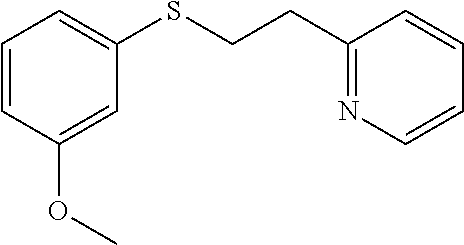
C00016
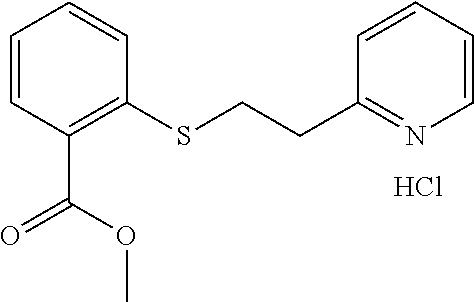
C00017
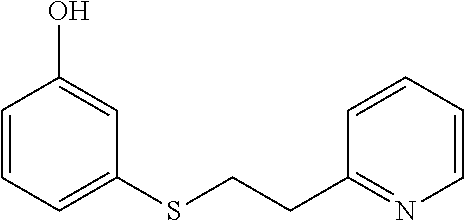
C00018
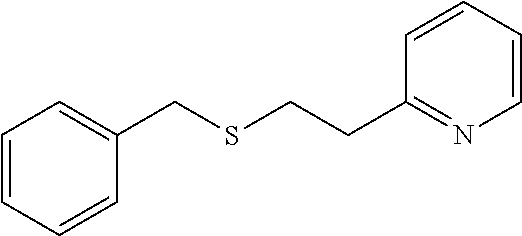
C00019
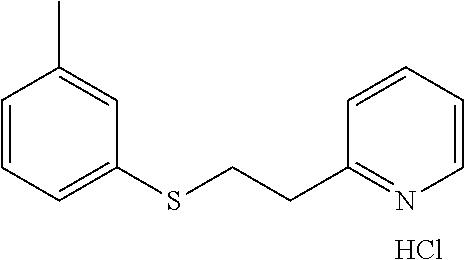
C00020
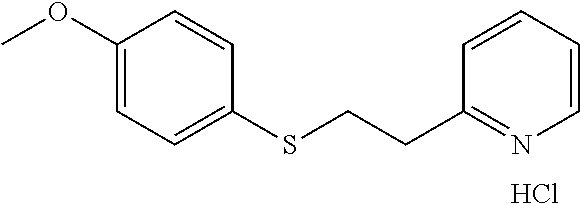
C00021

C00022
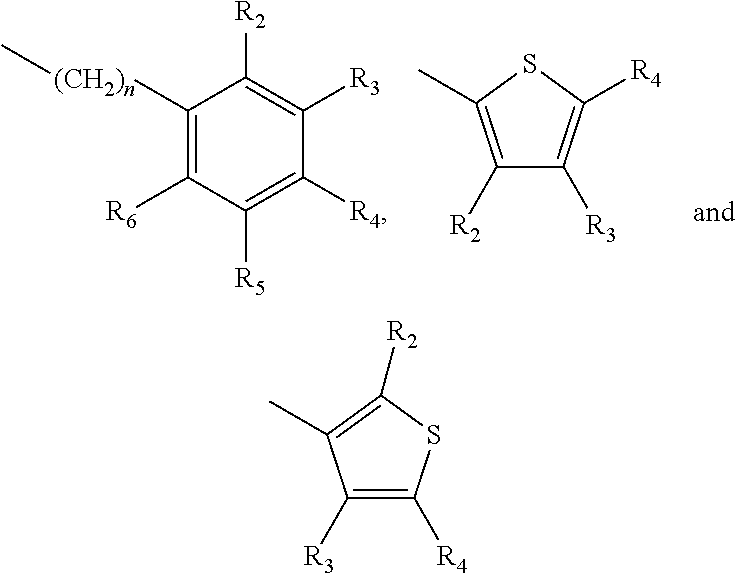
C00023
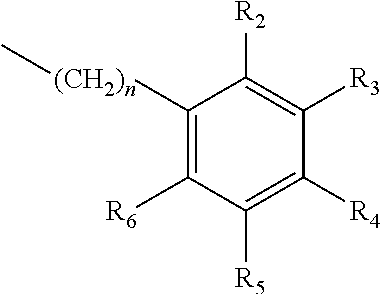
C00024
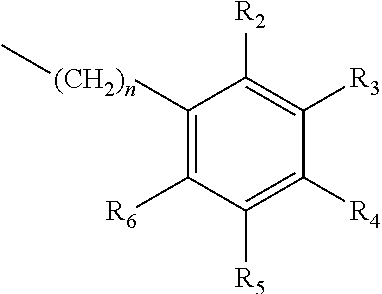
C00025

C00026
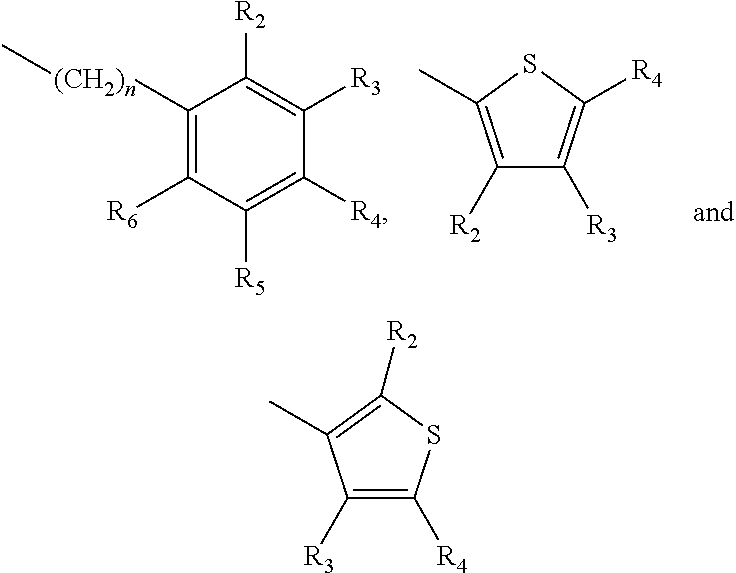
C00027

C00028
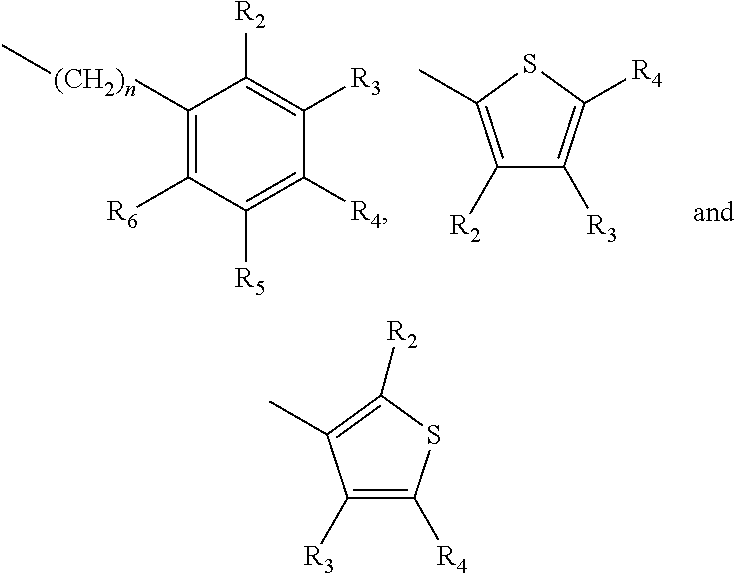
C00029

C00030
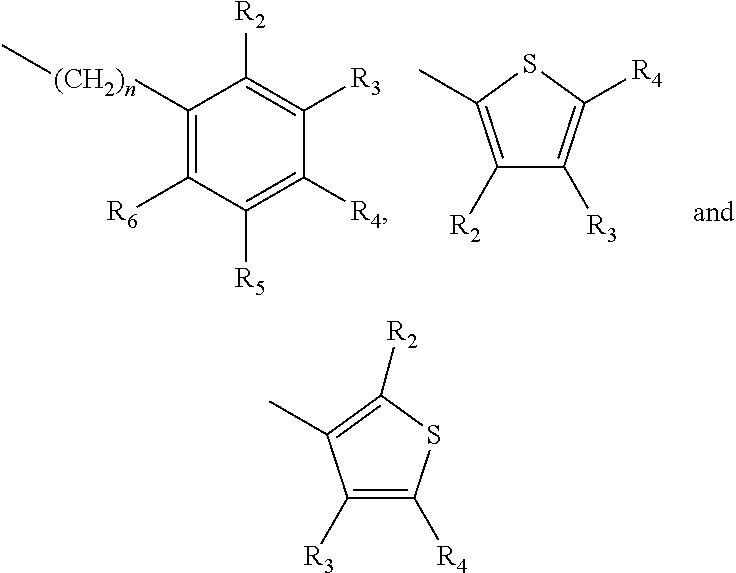
XML
uspto.report is an independent third-party trademark research tool that is not affiliated, endorsed, or sponsored by the United States Patent and Trademark Office (USPTO) or any other governmental organization. The information provided by uspto.report is based on publicly available data at the time of writing and is intended for informational purposes only.
While we strive to provide accurate and up-to-date information, we do not guarantee the accuracy, completeness, reliability, or suitability of the information displayed on this site. The use of this site is at your own risk. Any reliance you place on such information is therefore strictly at your own risk.
All official trademark data, including owner information, should be verified by visiting the official USPTO website at www.uspto.gov. This site is not intended to replace professional legal advice and should not be used as a substitute for consulting with a legal professional who is knowledgeable about trademark law.